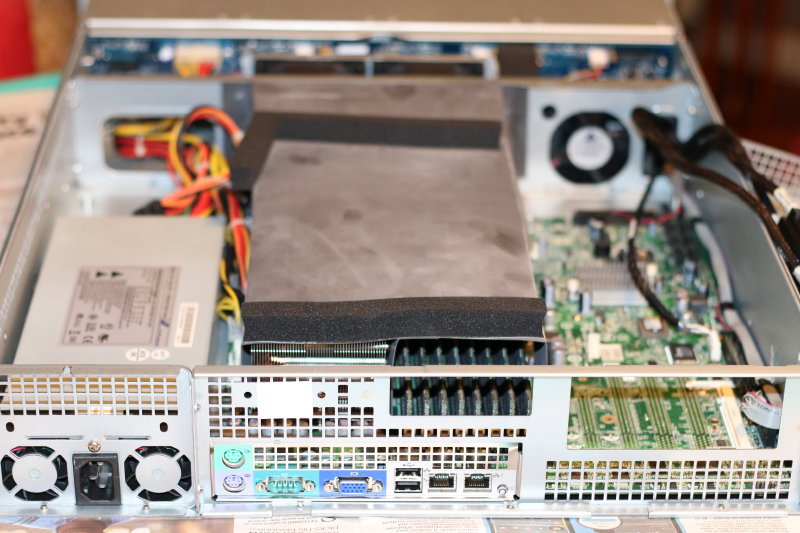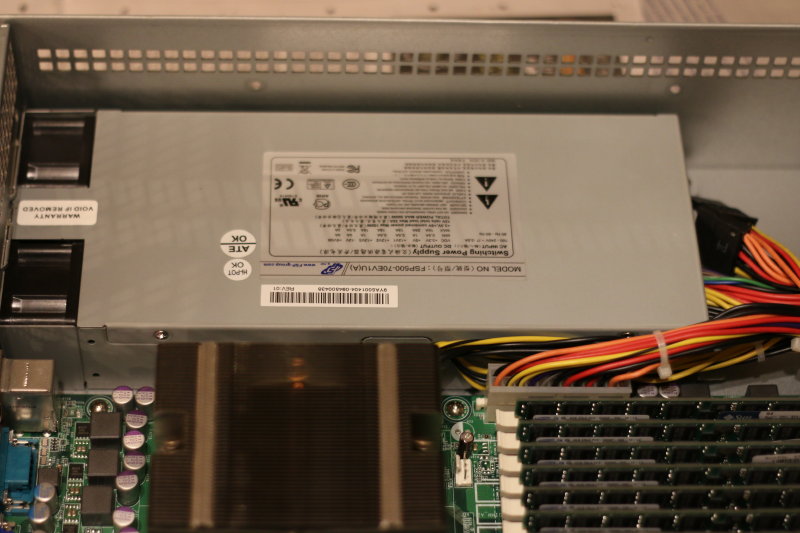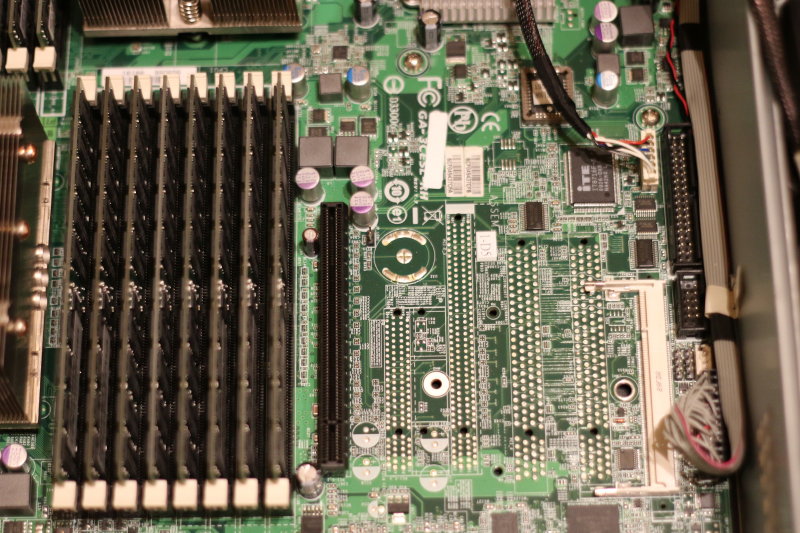(Photographs to follow)
A while back I reviewed the Dell FS12-NV7 – a 2U rack server being sold cheap by all and sundry. It’s a powerful box, even by modern standards, but one of its big drawbacks is the disk system it comes with. But it needn’t be.
There are two viable solutions, depending on what you want to do. You can make use of the SAS backplane, using SAS and/or SATA drives, or you can go for fewer SATA drives and free up one or more PCIe slots as Plan B. You probably have an FS12 because it looks good for building a drive array (or even FreeNAS) so I’ll deal with Plan A first.
Like most Dell servers, this comes with a Dell PERC RAID SAS controller – a PERC6/i to be precise. This ‘I’ means it has internal connectors; the /E is the same but its sockets are external.
The PERC connects to a twelve-slot backplane forming a drive array at the front of the box. More on the backplane later; it’s the PERCs you need to worry about.
The PERC6 is actually an LSI Megaraid 1078 card, which is just the thing you need if you’re running an operating system like Windows that doesn’t support a volume manager, striping and other grown-up stuff. Or if your OS does have these features, but you just don’t trust it. If you are running such an OS you may as well stick to the PERC6, and good luck to you. If you’re using BSD (including FreeNAS), Solaris or a Linux distribution that handles disk arrays, read on. The PERC6 is a solution to a problem you probably don’t have, but in all other respects its a turkey. You really want a straightforward HBA (Host Bus Adapter) that allows your clever operating system to talk directly with the drives.
Any SAS card based on the 1078 (such as the PERC6) is likely to have problems with drives larger than 2Tb. I’m not completely sure why, but I suspect it only applies to SATA. Unfortunately I don’t have any very large SAS drives to test this theory. A 2Tb limit isn’t really such a problem when you’re talking about a high performance array, as lots of small drives are a better option anyway. But it does matter if you’re building a very large datastore and don’t mind slower access and very significant resilvering times when you replace a drive. And for large datastores, very large SATA drives save you a whole lot of cash. The best capacity/cost ratio is for 5Gb SATA drives
Some Dell PERCs can be re-flashed with LSI firmware and used as a normal HBA. Unfortunately the PERC6 isn’t one of them. I believe the PERC6/R can be, but those I’ve seen in a FS12 are just a bit too old. So the first thing you’ll need to do is dump them in the recycling or try and sell them on eBay.
There are actually two PERC6 cards in most machine, and they each support eight SAS channels through two SFF-8484 connectors on each card. Given there are twelve drives slots, one of the PERCs is only half used. Sometimes they have a cable going off to a battery located near the fans. This is used in a desperate attempt to keep the data in the card’s cache safe in order to avoid write holes corrupting NTFS during a power failure, although the data on the on-drive caches won’t be so lucky. If you’re using a file system like that, make sure you have a UPS for the whole lot.
But we’re going to put the PERCs out of our misery and replace them with some nice new LSI HBAs that will do our operating system’s bidding and let it talk to the drives as it knows best. But which to pick? First we need to know what we’re connecting.
Moving to the front of the case there are twelve metal drive slots with a backplane behind. Dell makes machines with either backplanes or expanders. A backplane has a 1:1 SAS channel to drive connection; an expander takes one SAS channel and multiplexes it to (usually) four drives. You could always swap the blackplane with an expander, but I like the 1:1 nature of a backplane. It’s faster, especially if you’re configured as an array. And besides, we don’t want to spend more money than we need to, otherwise we wouldn’t be hot-rodding a cheap 2U server in the first place – expanders are expensive. Bizarrely, HBAs are cheap in comparison. So we need twelve channels of SAS that will connect to the sockets on the backplane.
The HBA you will probably want to go with is an LSI, as these have great OS support. Other cards are available, but check that the drivers are also available. The obvious choice for SAS aficionados is the LSI 9211-8i, which has eight internal channels. This is based on an LSI 2000 series chip, the 2008, which is the de-facto standard. There’s also four-channel -4i version, so you could get your twelve channels using one of each – but the price difference is small these days, so you might as well go for two -8i cards. If you want cheaper there are 1068-based equivalent cards, and these work just fine at about half the price. They probably won’t work with larger disks, only operate at 3Gb and the original SAS standard. However, the 2000 series is only about £25 extra and gives you more options for the future. A good investment. Conversely, the latest 3000 series cards can do some extra stuff (particularly to do with active cables) but I can’t see any great advantage in paying megabucks for one unless you’re going really high-end – in which case the NV12 isn’t the box for you anyway. And you’d need some very fast drives and a faster backplane to see any speed advantage. And probably a new motherboard….
Whether the 6Gb SAS2 of the 9211-8i is any use on the backplane, which was designed for 3Gb, I don’t know. If it matters that much to you you probably need to spend a lot more money. A drive array with a direct 3Gb to each drive is going to shift fast enough for most purposes.
Once you have removed the PERCs and plugged in your modern-ish 9211 HBAs, your next problem is going to be the cable. Both the PERCs and the backplane have SFF-8484 multi-lane connectors, which you might not recognise. SAS is a point-to-point system, the same as SATA, and a multi-lane cable is simply four single cables in a bundle with one plug. (Newer versions of SAS have more). SFF-8484 multi-lane connectors are somewhat rare, (but unfortunately this doesn’t make them valuable if you were hoping to flog them on eBay). The world switched quickly to the SFF-8087 for multi-lane SAS. The signals are electrically the same, but the connector is not.
So there are two snags with this backplane. Firstly it’s designed to work with PERC controllers; secondly it has the old SFF-8484 connectors on the back, and any SAS cables you find are likely to have SFF-8087.
First things first – there is actually a jumper on the backplane to tell it whether it’s talking to a PERC or a standard LSI HBA. All you need to do is find it and change it. Fortunately there are very few jumpers to choose from (i.e. two), and you know the link is already in the wrong place. So try them one at a time until it works. The one you want may be labelled J15, but I wouldn’t like to say this was the same on every variant.
Second problem: the cable. You can get cables with an SFF-8087 on one end and an SFF-8484 on the other. These should work. But they’re usually rather expensive. If you want to make your own, it’s a PITA but at least you have the connectors already (assuming you didn’t bin the ones on the PERC cables).
I don’t know what committee designed SAS cable connectors, but ease of construction wasn’t foremost in their collective minds. You’re basically soldering twisted pair to a tiny PCB. This is mechanically rubbish, of course, as the slightest force on the cable will lift the track. Therefore its usual to cover the whole joint in solidified gunk (technical term) to protect it. Rewiring SAS connectors is definitely not easy.
I’ve tried various ways of soldering to them, none of which were satisfactory or rewarding. One method is to clip the all bare wires you wish to solder using something like a bulldog clip so they’re at lined up horizontally and then press then adjust the clamp so they’re gently pressed to the tracks on the board, making final adjustments with a strong magnifying glass and a fine tweezers. You can then either solder them with a fine temperature-controlled iron, or have pre-coated the pads with solder paste and flash across it with an SMD rework station. I’d love to know how they’re actually manufactured – using a precision jig I assume.
The “easy” way is to avoid soldering the connectors at all; simply cut existing cables in half and join one to the other. I’ve used prototyping matrix board for this. Strip and twist the conductors, push them through a hole and solder. This keeps things compact but manageable. We’re dealing with twisted pair here, so maintain the twists as close as possible to the board – it actually works quite well.
However, I’ve now found a reasonably-priced source of the appropriate cable so I don’t do this any more. Contact me if you need some in the UK.
So all that remains is to plug your HBAs to the backplane, shove in some drives and you’re away. If you’re at this stage, it “just works”. The access lights for all the drives do their thing as they should. The only mystery is how you can get the ident LED to come on; this may be controlled by the PERC when it detects a failure using the so-called sideband channel, or it may be operated by the electronics on the backplane. It’s workings are, I’m afraid, something of a mystery still – it’s got too much electronics on board to be a completely passive backplane.
Plan B: SATA
If you plan to use only SATA drives, especially if you don’t intend using more than six, it makes little sense to bother with SAS at all. The Gigabyte motherboard comes with half a dozen perfectly good 3Gb SATA channels, and if you need more you can always put another controller in a PCIe slot, or even USB. The advantages are lower cost and you get to free up two PCIe slots for more interesting things.
The down-side is that you can’t use the SAS backplane, but you can still use the mounting bays.
Removing the backplane looks tricky, but it really isn’t when you look a bit closer. Take out the fans first (held in place by rubber blocks), undo a couple of screws and it just lifts and slides out. You can then slot and lock in the drives and connect the SATA connectors directly to the back of the drives. You could even slide them out again without opening the case, as long as the cable was long enough and you manually detached the cable it when it was withdrawn. And let’s face it – drives are likely to last for years so even with half a dozen it’s not that great a hardship to open the case occasionally.
Next comes power. The PSU has a special connector for the backplane and two standard SATA power plugs. You could split these three ways using an adapter, but if you have a lot of drives you might want to re-wire the cables going to the backplane plug. It can definitely power twelve drives.
And that’s almost all there is to it. Unfortunately the main fans are connected to the backplane, which you’ve just removed. You can power them from an adapter on the drive power cables, but there are unused fan connectors on the motherboard. I’m doing a bit more research on cooling options, but this approach has promising possibilities for noise reduction.




